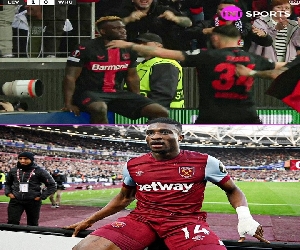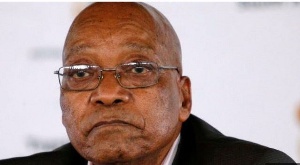Opinions of Friday, 22 December 2023
Columnist: Jkahia
Gindaabol Pii pacification (The sacred mount of Gindaabol-Jentilpe)
Gindaabol is a village near Sawla in the Sawla-Tuna-Kalba District of the Savannah Region of Ghana. The name Gindaabol is the village's original name, but it is currently spelled Jentilpe. For the writing and historical records' sake, the original name shall be used. The reason is that the original name is consistent with the history of the Vagla people and the history of the village.
The people of Gindaabol are Vagla and they speak the Vagli Language which belongs to the Gur language of the Sissala, Kasem, Tampulma, Chakala, and Mo (Deg) among others of Northern Ghana. The people of Gindaabol had originally settled in the Central Part of Gonja around Hawaii near Yapei but later moved to join their larger Vagla people on the mainland. Gindaabol is closely connected with the people of Kunlog. Kunlog is a much older Vagla village and ancient Vagla Community.
The Chiefs and People of Gindaabol (Jentilpe) experienced a series of wars and conflicts but remained on their land. The Chiefs (Gindaabol Koro/Heuhin), the elders (Nabonzi), and the people encountered with the intrusion of the Ashantis, the intrusion of the Black Dagombas, and the last groups of people or tribes encountered in Gindaabol are the Ngbanya under the leadership of Sumaila Jakpa in a few centuries ago. The relatively recent group of people or tribes that settled in Gindaabol were the Lobis close to a century ago. The Gindaabol people are Vagla by ethnicity and their main occupation is farming with other associated activities including hunting for game.
Two prominent traditional leaders have exercised their authority in Gindaabol
namely the Gindaabol Heuhin with the appellation Siayo and the Gindaabol Koro with the appellation Jara. These are two revered leaders in Gindaabol in the history of the Vagla. Largely the secular powers are in the Gindaabol Koro while the religious powers are in the Gindaabol Heuhin and the co-existence of the two powerful leaders has been so in history and they do exercise their powers based on the customs and traditions of Gindaabol.
In short, the elders and the people of Gindaabol highly revered the Gindaabol Koro and the Gindaabol Heuhin. These two traditional leaders have always been the center of the Ginadaabol Pii Pacification for over a century among Gonjas.
Gindaabol shares land boundaries with the ancient village of Kunlog to the northeast, Gorbol to the East, Sawla to the West, and Chorbang and Tainbol/Sornyor to the South respectively. In the 18th and 19th Centuries, the Gindabol village and its immediate environs experienced new groups and developments. This period marked the presence of the Ngbanya tribe and their
chieftaincy systems along with the older one (Vagla Chiefdom under the leadership of Gindaabol Koro and Gindabbol Heuhin).
This period also marked the establishment of the Nyange as the traditional capital of the Ngbanya tribe. Per the narrative of Ngbanya, they arrived in the Vagla enclaves from Mande somewhere in Mali with some links with the ancient empires and such systems of rulership were to be established at Nyange near Gindaabol. Two prominent Chiefs were established, one in Beel (now Bole) and another at Kong (near Soma/Tuna). Some other Chiefs of the Ngbanya were found in other communities near the Tampulma and the Hanga enclaves and beyond. All these Ngbanya Chiefs have their senior Chief (Kiyagbonwura) at Nyange.
This is the era in which the Vagla and their Chiefs co-existed with the newly formed groups and their Chiefs (the Wura). Thus, the Vagla co-existed with Ngbanya and their Chiefs in and around Gindaabol. Per the Vagla history and narratives, there was an accord among the Ngbanya, largely between the Beel (Bole) and the Kong people among others where they sent back to their roots across the Black Volta where they took some money or treasures for the establishment of their kingdom at Nyange. Such monies or treasures were expected to be repaid to their borrower outside the Black Volta River basin. It happened that the money or treasures were becoming a problem, and this created some disagreements or tensions between the Beel (Bole) Ngbanya and the Kong
Ngbanya.
Such an internal feud among the Ngbanya was not resolved amicably and it eventually resulted in a kind of fight between the Beel Ngbanya and the Kong Ngbanya. This was when some mercenaries were hired to attack the Ngbanya and some Vagla communities including the Ngbanya traditional capital Nyange near Gindaabol. Three such attacks on the Ngbanya were repelled by the Vagla fighters and warriors largely in and around Gindaabol. The invaders or the foreign invaders warned the Vaglas to stay away from the Ngbanya matters or feud. On
On one such occasion, the invaders arrested some Ngbanya people and took them away heading towards the Black Volta.
The Vagla in Gindaabol (Jentilpe) intervened for the release of the
Ngbanya people. Again, the invaders warned the Vagla to stay away from getting into their armed conflict with the Ngbanya and their Chiefs (Wuras). The invaders then adopted a strategy in their next (the third) encounter with the Vagla people in Gindaabol who were obstructing their war/fight with the Ngbanya. The invaders made the Vagla believe that there would be no more war or fighting for the sake of peace.
At this stage, the invaders assured the people of Gindaabol (Jentilpe) that there would be no war. So, the people of Gindaabol largely Vaglas and with a few Ngbanya surrendered all their arms for peaceful co-existence. This was where the people of Gindaabol brought out their guns, bows and arrows, and all forms of war tools for destruction. The invaders also made the people of Gindaabol believe that the destruction of all their war tools would mark the end of invasion and fights. Water was poured into the guns and the other tools were destroyed or made useless for fighting. After this period of disarmament, the leader of the invaders destroyed what they also had with them, assurance that there would be no fight among the Ngbanya and there would be no fight that would involve the Vagla. Suddenly the leader of the invaders shouted “Kavaga
Kabera”.
This slogan was interpreted to mean that the Vagla people were now part of the war that was limited to only the Ngbanya people. This was shocking as the two times victory of the Vagla against the invaders was ending with the grand scheme of the invaders. The next shout was the call for another larger army of invaders who were hiding in the bushes around Gindaabol. This marked the victory of the invaders against the Vagla people and the Ngbanya people around Gindaabol, Nyange, Kalinbol, and Teinbol among several communities near Gindaabol. These
foreign invaders were known as the Samori warriors and the war against the Vagla and the Ngbanya became known as the Samori War against Gonja.
Two Gonja tribes namely Vagla and Ngbanya suffered the Samori war. It is important to note that the VAGLA tribe of Gonja suffered most of the deaths in Gindaabol and the surrounding communities/villages. The large number of deaths was because of the use of gunpowder for mass killings that affected the Vagla
and the Beel (Bole) Ngbanya. It was believed that only a few people escaped the Samori War of 1895-97 in Gindaabol. It was also believed that the few who escaped were either the lucky ones who managed to escape into the bush or those fortified ones who magically vanished from the slaughter of the Samori warriors against Gonja.
Relevance of Gindaabol Mass Grave or the Sacred Mount of Jentilpe (GINDAABOL PII):
Gindaabol Pii in Vagla means Mass Grave. Pii in Vagli means Mount and the traditional feast is usually organized by the Chiefs and People of Gindaabol to mark or remember the barbaric attacks of the Samori Warriors against the Gonjas (Vagla and the Ngbanya). The Traditional Feast or the Gindaabol Pii Pacification is usually performed when the mass grave is going down and the people must build on the mount with the intention not to expose any part of the dead who were buried in the mass grave in Gindaabol. The Mount in Gindaabol was where the
victims of war were covered up with the mount (PII).
The pacifications are necessary to appease the spirits of the dead Vagla/Ngbanya. Traditional prayers are often offered by Gindaabol Heuhin (Siayo) and Gindaabol Koro (Jara) to avert such occurrences in any part of Gonja.
Invitations are usually made to all Ngbnaya Chiefs including the Yagbonwura, the Paramount Chiefs, Divisional Chiefs, and Sub-Chiefs to come and witness the pacification rites at Gindaabol/Jentilpe, Savannah Region, Ghana. Also, Yagbonwuras often take part in the pacification rites organized by Yagbon Dankarehina (Yagbon Dankarewura at Gindaabol) As part of the pacification rites mixed foods are prepared for consumption, known as Diu Koo Zaa.
The Feast of Sacrifices is important for the unity of Gonja. This sacred mount pacification also shows the unity and the diversity of the Gonja Tribes (co-existence of the Vagla Tribe and the Ngbanya Tribe) in Gonja (Western Gonja).
Some Brief History of the Samori Toure War (The Vagla Perspectives of the Samori War) Samori was a “slave trader” in the words of Shield (1926) wondering for slaves and rulership. This man Samori caused great harm to the people of the Bole District of the Western Gonja in the Northern Territory. Besides the Samori war, the area also suffered the effects of influenza which claimed many lives. The Samori crossed the Black Volta from the Ivory Coast, killed many people in the Bole area, and took away many cattle across the Black Volta for various
reasons. Some of the people moved further South others moved outside the area or the country until the British arrived.
Gindaabol (Jentilpe lies between Gurupe to Jang country or an area where there are many of the natives of Gonja-the Vagella or Vagla people. Some of the Vagla
people were around Senyon before Jama where the Mo (Deg) people lived (Shield, 1926, pp.425-426). Moreover, history has it that Samori Toure was more to be “a warrior than a trader” (Azarya, 1980, p. 436). This historical write-up is in line with the oral history of the Vagla people. Samori started his warrior skills as a Dyula Chief, in the 1850s and established his military organization in the 1860s. Samori began expanding his territory beyond Bamako Mali
into other countries/Kingdoms in West Africa.
Samori Toure had to move towards the Black Volta in a way to move away from the French rule and confrontation with the French Authority (the Colonial Master/Administration). This brought Samori Toure closer to Buna, Kong, and
Bondugu which he destroyed in those Dyula towns in the early 1890s. Samori expanded his state or territories through some trade routes and waged wars largely against societies that crossed his line or disrupted his path of aggression. Samori eventually entered and crossed the Black Volta and suffered some defeats at the hands of the Vagla largely Fetish in the First and the Second Phase.
But used a superior tactic of deception in the name of Peace Accord to disarm the Vaglas leading to the annellation of Gindaabol and its immediate communities of the Vagla Chiefdoms which affected the Gonjas (Vagla-Ngbanya). The Vagla narrative shows that the Vagla people suffered the most. Also, among the Ngbanhya the Bole Ngbanya suffered more of the killings than other Ngbanya, Kong was spared in the barbaric acts of the Samori War for strategic reasons
against Bole Ngbanya. Thus, the debacle between the Ngbnaya of Bole and the Ngbnaya of Kong remains to date.
These are the perspectives of the Vagla people as far as the Samori war is
concerned and as far as the GINDAABOL PII (The Sacred Mount of Jentilpe) is concerned. It is a traditional Feast of Sacrifices and Pacification under the traditional leadership of the Vagla and Ngbanya. Prayers to avert such calamities are often made for all the Gonja tribes and their Chiefs. The Gindaabol Pii shows the importance of the Yagbon Dankarehina (Dankarewuruana)
in Gonja State or Gbanya Affairs and the larger Gonja Kingdom.
Vagla remains very critical and pivotal in Gonja and all spheres of Yagbon affairs. Vagla matters in the customs and traditions of Gonja (Gbanya state / Gonja kingdom or Yagbon state affairs).
In conclusion, the Gindaabol Pii pacification is one of the many traditional events that show or depict the beauty in the diversity of the Vagla and Ngbanya tribes collectively called Gonjas.













